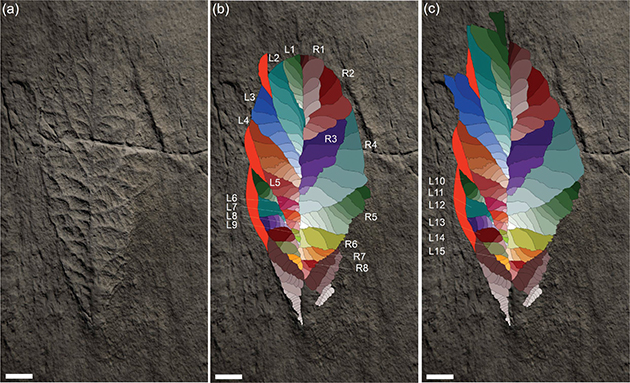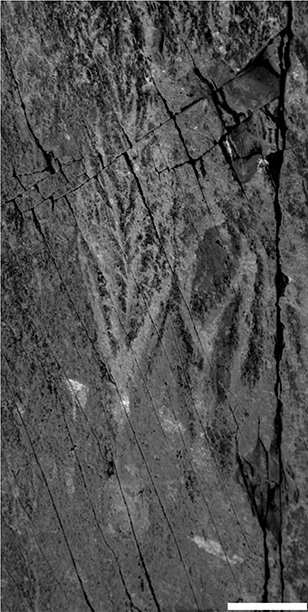A critical reappraisal of the holotype of Beothukis mistakensis, a unique exceptionally preserved rangeomorph organism from Mistaken Point, Newfoundland, Canada
Reevaluación crítica del holotipo de Beothukis mistakensis, único organismo rangeomorfo excepcionalmente preservado en Mistaken Point, Terranova, Canadá
R.S. Taylor1, J.B. Hawco1, R. Nichols2, D. McIlroy1
1Department of Earth Sciences, Memorial University of Newfoundland, St. John’s, NL, Canada. Email: rodt@mun.ca; ORCID ID: http://orcid.org/0000-0003-3072-6040, http://orcid.org/0000-0001-9162-2013, http://orcid.org/0000-0001-9521-499X
2Palaeocreations, Bristol, UK. ORCID ID: http://orcid.org/0000-0001-8980-7297
| |
ABSTRACT
The holotype of Beothukis mistakensis in Mistaken Point, Newfoundland, is the only currently known specimen that can be definitely placed within the species. Morphological differences between the holotype of B. mistakensis and the well-constrained species plumosa suggest that the two are not congeneric and Culmofrons plumosa should be retained as a valid taxon as originally established.
Keywords: Beothukis; Rangeomorph; Mistaken Point; Ediacaran; Newfoundland.
|
| |
RESUMEN
El holotipo de Beothukis mistakensis en Mistaken Point, Terranova, es el único ejemplar actualmente conocido que puede ser colocado definitivamente dentro de la especie. Las diferencias morfológicas entre el holotipo de B. mistakensis y la especie plumosa sugieren que ambas no son congéneres y que Culmofrons plumosa debería conservarse como un taxón válido tal como se estableció originalmente.
Palabras clave: Beothukis; Rangeomorfo; Mistaken Point; Ediacárico; Terranova.
|
IntroductionTOP
The Mistaken Point Ecological Reserve is a UNESCO World Heritage Site situated on the southeast coast of Newfoundland, Canada. It is home to multiple localities preserving complex accumulations of a group of late Ediacaran fossils known as the Avalonian Assemblage (Waggoner, 2003). These fossiliferous sites represent whole communities of deepsea seafloor-dwelling organisms that were preserved as ‘snapshots in time’ through burial by volcanic ash (Clapham et al., 2003; Ichaso et al., 2007) ranging in age from 570.94 ± 0.38 to 566.25 ± 0.35 Ma (Pu et al., 2016). Beothukis mistakensis (Fig. 1A) is one of the most recognizable Ediacaran fossils from Mistaken Point. It has been illustrated in numerous publications, although it represents an exceptionally small component of the total fossil assemblage. It is perhaps best known for its occurrence on the Mistaken Point ‘E surface’ in a small area colloquially known as ‘Seilacher’s Corner’, in close proximity to other well-known Ediacaran taxa (e.g. Fractofusus, Charniodiscus) in a highly photogenic portion of the surface.
|
 Figure 1.—A. Plastotype of the Beothukis mistakensis holotype, Mistaken Point Ecological Reserve. B. Interpretive drawing showing the first order units, labelled L1-9 and R1-8 (second order rangeomorph units are coloured so as to be progressively darker closer to the margin of the fossil); the orange coloured features are arcuate units with non-rangeomorph sub-units. (c) Secondary growth occurs at the tips of some first order units; the first arcuate unit on the left overgrows the secondary growths, implying its later development relative to secondary growth of unit L2. Scale bars = 1 cm. Figure 1.—A. Plastotype of the Beothukis mistakensis holotype, Mistaken Point Ecological Reserve. B. Interpretive drawing showing the first order units, labelled L1-9 and R1-8 (second order rangeomorph units are coloured so as to be progressively darker closer to the margin of the fossil); the orange coloured features are arcuate units with non-rangeomorph sub-units. (c) Secondary growth occurs at the tips of some first order units; the first arcuate unit on the left overgrows the secondary growths, implying its later development relative to secondary growth of unit L2. Scale bars = 1 cm.
|
|
Beothukis mistakensis was a uniterminal, frond-shaped organism with an oval to spatulate outline. Like all rangeomorphs, B. mistakensis is composed of a complex modular architecture, with each component unit being made up of similar but smaller units arranged
in a fractal-like manner (Narbonne, 2004; Brasier et al., 2012). The taxonomic status of the genus Beothukis is currently uncertain: it has been amended to include specimens with a stem and basal disc (Brasier et al. 2012), although these features are not preserved on the holotype. Liu et al. (2016) reconsidered Beothukis mistakensis in the context of new discoveries of Culmofrons plumosa (LaFlamme et al., 2012; Fig. 2). C. plumosa was considered to possess a frond with similar gross morphology to Beothukis, but also a stem and holdfast. Culmofrons plumosa was thus considered to be a junior synonym of B. mistakensis, thereby creating the new taxon Beothukis (Culmofrons) plumosa. Part of the rationale for this decision was on the basis that continuous characters (i.e., stem length) are unsuitable for
genus-level differentiation of taxa (Liu et al., 2016), the authors instead recommended utilizing gross architecture, the presence/absence of morphological features, and overall
growth programme. The number of second order rangeomorph branches (8-12 in B. (C.) plumosa versus 5-8 in B. mistakensis) is an important feature used by Liu et al. (2016) to distinguish between the two species. The objectives of this study are to re-assess the morphology of the holotype of B. mistakensis, and to re-examine the relationship between B. mistakensis and B. (C.) plumosa.
|
 Figure 2.—Holotype of Beothukis (Culmofrons) plumosa from Lower Mistaken Point, Mistaken Point Ecological Reserve. Scale bar: 2 cm. Figure 2.—Holotype of Beothukis (Culmofrons) plumosa from Lower Mistaken Point, Mistaken Point Ecological Reserve. Scale bar: 2 cm.
|
|
Results and discussionTOP
Careful study of the B. mistakensis holotype reveals a considerably more complex morphology than previously recognized. The frond is asymmetrical, with the left
side being made up of nine primary order units (‘branches’) while the right side consists of only eight such units (Fig. 1B). Primary order units were added sequentially from the distal tip of the frond towards its base, our interpretation of the
primary order units differs from earlier authors but is based on retention of equivalent number of orders of “branching” within
all primary order units. Although the overall outline of the organism is approximately symmetrical across the midline, the
units making up the left and right sides show dissimilar sizes and orientations. The number of secondary order rangeomorph
units within each primary order unit varies across the medial axis, compensating for the variability in size and shape of
the primary units to maintain the overall frond shape. The angle of the primary order units relative to the midline increases
from being acute at the distal tip of the frond to being approximately perpendicular near the base of the frond. Tertiary
order rangeomorph branches are rotated and furled near the central axis but displayed and furled when bound proximally and
distally by secondary growth. The tertiary units located at the lateral margin of the frond show variable morphologies.
Secondary growth occurs around the fringes of several of the first order units on the left side of the organism (Fig. 1C). Arcuate units without typical rangeomorph branching are also visible on the left-hand side of the holotype, in places overgrowing
the secondary fringe growth. Several first order units without rangeomorph branching are located near the basal region of
the organism, each composed of multiple rectangular second-order units and obliquely adjoining the frond’s central axis.
The paratype of B. mistakensis was also examined as a part of this study, revealing that there are 3 vanes of growth within the fossil. We thus determine
that it is not congeneric with the holotype and thus needs to be reassigned to a different taxon. Of the many fossils previously described as Beothukis, none are morphologically comparable to the holotype, beyond perhaps having a spatulate outline. The other material is thus in need of reassessment, which is the focus of a separate morphometric study.
Several important morphological differences between B. mistakensis (Fig. 1A) and B. (C.) plumosa (Fig. 2) have been identified as a result of this study:
| • |
The primary order branches of B. mistakensis are unequal and asymmetrical across a straight central axis, while the type specimen of B. (C.) plumosa possesses up to five pairs of equal but alternating primary order branches across its two rows, producing a zig-zag axis. |
| • |
The primary branches of B. mistakensis are small near the base and do not attach to a stem, while the primary branches are largest close to the stem in B. (C.) plumosa and attach directly to it. |
| • |
The largest second-order units in B. mistakensis are located close to the frond’s edge and in the middle of the organism, while in B. (C.) plumosa the largest second-order units are situated near the axis and close to the base of the frond. |
| • |
The morphology of the third-order branches in B. mistakensis vary depending on their position within the frond, while in B. (C.) plumosa most of the tertiary branches appear to be rotated and furled. |
| • |
Lateral branches are found at the base of B. mistakensis but are not observed in B. (C.) plumosa. |
ConclusionsTOP
The holotype of Beothukis mistakensis is the only currently known specimen that can be definitely placed within the species. Morphological differences between the holotype of B. mistakensis and the well-constrained species plumosa suggest that the two are not congeneric and C. plumosa should be retained as a valid taxon as originally established. We hope that further study of the Avalonian Assemblage in Newfoundland will reveal more material belonging to B. mistakensis, and that morphometric analysis of the spatulate fronds will provide rationale for discrimination of the diversity within that morphospace.
ReferencesTOP
| ○ |
Brasier, M.D.; Antcliffe, J.B. & Liu, A.G. (2012). The architecture of Ediacaran fronds. Palaeontology, 55: 1105–1124. https://doi.org/10.1111/j.1475-4983.2012.01164.x |
| ○ |
Clapham, M.E.; Narbonne, G.M. & Gehling, J.G. (2003). Paleoecology of the oldest known animal communities: Ediacaran assemblages at Mistaken Point, Newfoundland. Paleobiology, 29: 527–544. https://doi.org/10.1666/0094-8373(2003)029<0527:POTOKA>2.0.CO;2 |
| ○ |
Ichaso, A.A.; Dalrymple, R.W. & Narbonne, G.M. (2007). Paleoenvironmental and basin analysis of the Late Neoproterozoic (Ediacaran) Upper Conception and St. John’s Groups, West Conception Bay, Newfoundland. Canadian Journal of Earth Sciences, 44: 25–41. https://doi.org/10.1139/e06-098 |
| ○ |
LaFlamme, M.; Flude, L.I. & Narbonne, G.Y. (2012). Ecological tiering and the evolution of a stem: the oldest stemmed frond from the Ediacaran of Newfoundland, Canada. Journal of Palaeontology, 86: 193–200. https://doi.org/10.1666/11-044.1 |
| ○ |
Liu, A.G.; Matthews, J.J. & McIlroy, D. (2016). The Beothukis/Culmofrons problem and its bearing on Ediacaran macrofossil taxonomy: evidence from an exceptional new fossil locality. Palaeontology, 59: 45–58. https://doi.org/10.1111/pala.12206 |
| ○ |
Narbonne, G.M. (2004). Modular construction in the Ediacaran Biota. Science, 305: 1141–1144. https://doi.org/10.1126/science.1099727 |
| ○ |
Pu, J.P.; Bowring, S.A.; Ramezani, J.; Myrow, P.; Raub, T.D.; Landing, E.; Mills, A.; Hodgin, E. & Macdonald, F. A. (2016). Dodging Snowballs: Geochronology of the Gaskiers Glaciation and the first appearance of the Ediacaran Biota. Geology, 44:
955–958. https://doi.org/10.1130/G38284.1 |
| ○ |
Waggoner, B. (2003). The Ediacaran Biotas in space and time. Integrative and Comparative Biology, 843: 104–113. https://doi.org/10.1093/icb/43.1.104 |
Figure 1.—A. Plastotype of the Beothukis mistakensis holotype, Mistaken Point Ecological Reserve. B. Interpretive drawing showing the first order units, labelled L1-9 and R1-8 (second order rangeomorph units are coloured so as to be progressively darker closer to the margin of the fossil); the orange coloured features are arcuate units with non-rangeomorph sub-units. (c) Secondary growth occurs at the tips of some first order units; the first arcuate unit on the left overgrows the secondary growths, implying its later development relative to secondary growth of unit L2. Scale bars = 1 cm.